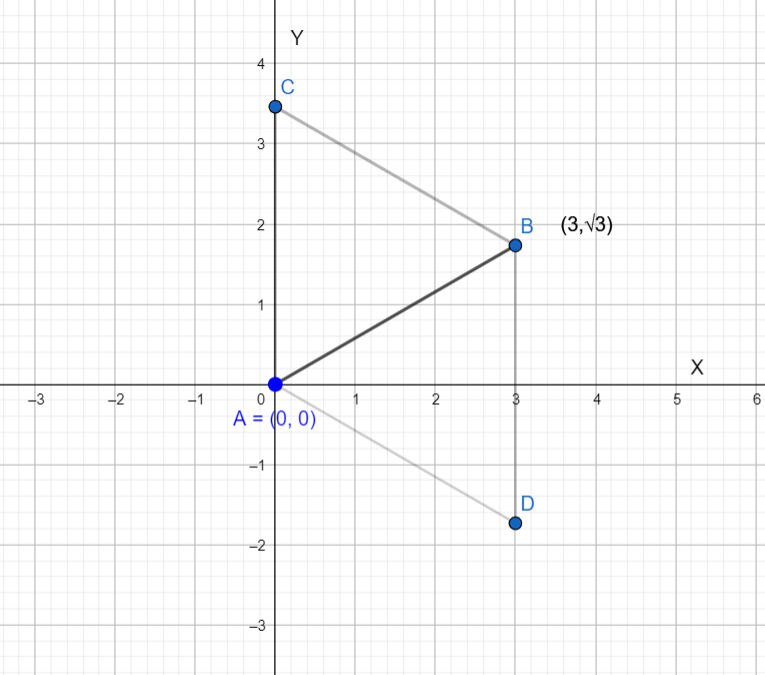
If two vertices of an equilateral triangle are $\left( 0,0 \right),\left( 3,\sqrt{3} \right)$ , find the third vertices of the triangle.
Answer
556.5k+ views
Hint: In equilateral triangle all angles are $\dfrac{\pi }{3}$ and length of all 3 sides are the same. In equilateral triangle altitudes and medians are the same for all sides. If we rotate point B with respect to point A by $\dfrac{\pi }{3}$ clockwise and anti-clockwise we will get C and D. We can use complex numbers to solve this question. Another method is to use coordinate geometry, first we will find the midpoint of AB then the equation of altitude through AB. We know that the third point will lie on that altitude at distance of height of the triangle.
Complete step-by-step solution:

2 points of an equilateral triangle are given as A and B Shown in the above graph.
A= $\left( 0,0 \right)$ and B=$\left( 3,\sqrt{3} \right)$
We have to find the third point of the equilateral triangle. There exist 2 points which will form an equilateral triangle with A and B. Let’s assume those points are C and D.
Rotating point B with respect to A by angle $\dfrac{\pi }{3}$ anti-clock wise we will get C.
Rotating point B with respect to A by angle $\dfrac{\pi }{3}$ clock wise we will get D.
We can use complex numbers to solve that. First we have to write the coordinate in complex Cartesian form. We have write X coordinate as real part and Y coordinate as complex part of complex number, that is $\left( 0,0 \right)$ = $0+i0$ and $\left( 3,\sqrt{3} \right)$ = $3+i\sqrt{3}$ .
If we rotate anti-clockwise a point $\left( {{x}_{2}},{{y}_{2}} \right)$ with respect to the point $\left( {{x}_{1}},{{y}_{1}} \right)$ by an angle $\alpha $ we have to multiply the vector from $\left( {{x}_{1}},{{y}_{1}} \right)$ to $\left( {{x}_{2}},{{y}_{2}} \right)$ with ${{e}^{i\alpha }}$ then add the result to point$\left( {{x}_{1}},{{y}_{1}} \right)$.
Complex Cartesian form of new point after rotating.
$\left( {{x}_{1}}+i{{y}_{1}} \right)+\left[ {{x}_{2}}-{{x}_{1}}+i({{y}_{2}}-{{y}_{1}}) \right]{{e}^{i\alpha }}$
${{e}^{i\alpha }}=\cos \alpha +i\sin \alpha $
In this case, we have
$\left( 3+i\sqrt{3} \right)\times {{e}^{i\dfrac{\pi }{3}}}=\left( 3+i\sqrt{3} \right)\times \left( \dfrac{1}{2}+i\dfrac{\sqrt{3}}{2} \right)$
= $0+i2\sqrt{3}$
So, D=$\left( 0,2\sqrt{3} \right)$
By rotating $\dfrac{\pi }{3}$ clockwise we will get point D we have to multiply with ${{e}^{-i\dfrac{\pi }{3}}}$
$\left( 3+i\sqrt{3} \right)\times {{e}^{-i\dfrac{\pi }{3}}}=\left( 3+i\sqrt{3} \right)\times \left( \dfrac{1}{2}-i\dfrac{\sqrt{3}}{2} \right)$
= $3-i\sqrt{3}$
So, C=$\left( 3,-\sqrt{3} \right)$.
Note: Remember the complex Cartesian form of coordinates and how to rotate a point with respect to another fixed point. We also can use geometry to solve this question. We can find the midpoint of the given side and thus can calculate the equation of altitude through the side. The third point will lie on that altitude and at a distance of 3 units from midpoint to both directions because the ratio between lengths of side to altitude is $1:\dfrac{\sqrt{3}}{2}$.
Complete step-by-step solution:

2 points of an equilateral triangle are given as A and B Shown in the above graph.
A= $\left( 0,0 \right)$ and B=$\left( 3,\sqrt{3} \right)$
We have to find the third point of the equilateral triangle. There exist 2 points which will form an equilateral triangle with A and B. Let’s assume those points are C and D.
Rotating point B with respect to A by angle $\dfrac{\pi }{3}$ anti-clock wise we will get C.
Rotating point B with respect to A by angle $\dfrac{\pi }{3}$ clock wise we will get D.
We can use complex numbers to solve that. First we have to write the coordinate in complex Cartesian form. We have write X coordinate as real part and Y coordinate as complex part of complex number, that is $\left( 0,0 \right)$ = $0+i0$ and $\left( 3,\sqrt{3} \right)$ = $3+i\sqrt{3}$ .
If we rotate anti-clockwise a point $\left( {{x}_{2}},{{y}_{2}} \right)$ with respect to the point $\left( {{x}_{1}},{{y}_{1}} \right)$ by an angle $\alpha $ we have to multiply the vector from $\left( {{x}_{1}},{{y}_{1}} \right)$ to $\left( {{x}_{2}},{{y}_{2}} \right)$ with ${{e}^{i\alpha }}$ then add the result to point$\left( {{x}_{1}},{{y}_{1}} \right)$.
Complex Cartesian form of new point after rotating.
$\left( {{x}_{1}}+i{{y}_{1}} \right)+\left[ {{x}_{2}}-{{x}_{1}}+i({{y}_{2}}-{{y}_{1}}) \right]{{e}^{i\alpha }}$
${{e}^{i\alpha }}=\cos \alpha +i\sin \alpha $
In this case, we have
$\left( 3+i\sqrt{3} \right)\times {{e}^{i\dfrac{\pi }{3}}}=\left( 3+i\sqrt{3} \right)\times \left( \dfrac{1}{2}+i\dfrac{\sqrt{3}}{2} \right)$
= $0+i2\sqrt{3}$
So, D=$\left( 0,2\sqrt{3} \right)$
By rotating $\dfrac{\pi }{3}$ clockwise we will get point D we have to multiply with ${{e}^{-i\dfrac{\pi }{3}}}$
$\left( 3+i\sqrt{3} \right)\times {{e}^{-i\dfrac{\pi }{3}}}=\left( 3+i\sqrt{3} \right)\times \left( \dfrac{1}{2}-i\dfrac{\sqrt{3}}{2} \right)$
= $3-i\sqrt{3}$
So, C=$\left( 3,-\sqrt{3} \right)$.
Note: Remember the complex Cartesian form of coordinates and how to rotate a point with respect to another fixed point. We also can use geometry to solve this question. We can find the midpoint of the given side and thus can calculate the equation of altitude through the side. The third point will lie on that altitude and at a distance of 3 units from midpoint to both directions because the ratio between lengths of side to altitude is $1:\dfrac{\sqrt{3}}{2}$.
Recently Updated Pages
The number of solutions in x in 02pi for which sqrt class 12 maths CBSE

Write any two methods of preparation of phenol Give class 12 chemistry CBSE

Differentiate between action potential and resting class 12 biology CBSE

Two plane mirrors arranged at right angles to each class 12 physics CBSE

Which of the following molecules is are chiral A I class 12 chemistry CBSE

Name different types of neurons and give one function class 12 biology CBSE

Trending doubts
One Metric ton is equal to kg A 10000 B 1000 C 100 class 11 physics CBSE

What is 1s 2s 2p 3s 3p class 11 chemistry CBSE

Discuss the various forms of bacteria class 11 biology CBSE

State the laws of reflection of light

Explain zero factorial class 11 maths CBSE

An example of chemosynthetic bacteria is A E coli B class 11 biology CBSE




